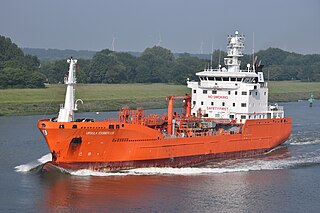Worldscale is a unified system of establishing payment of freight rate for a given oil tanker's cargo. Worldscale was established in November 1952 by London Tanker Brokers' Panel on the request of British Petroleum and Shell as an average total cost of shipping oil from one port to another by ship. A large table was created as result.
The same scale is used today, although it was merged with the American Tanker Rate Schedule (ATRS) in 1969. By 2002, the table included the average cost of 320,000 voyages of different combinations of one load and one discharge port to five loads and ten discharge ports. Worldscale is produced by Worldscale Association (NYC) Inc. for the Americas and by Worldscale Association (London) Ltd. for the rest of the world. The freight for a given ship and voyage is normally expressed in a percentage of the published rate and is supposed to reflect the freight market demand at the time of fixing.
Following are some samples.
| From Yokohama to: | US$/tonne | Miles |
|---|---|---|
| Adelaide | 10.60 | 10,574 |
| Aden | 12.39 | 13,038 |
| Chiba | 2.90 | 50 |
In negotiating a price to pay, the above table is referred to as WS100 or 100% of Worldscale. The actual price negotiated between shipowner and charterer can range from 1% to 1000% and is referred to respectively as WS1 to WS1000, depending on how much loss the first is willing to take on that voyage and how much the latter is willing to pay.

A container ship is a cargo ship that carries all of its load in truck-size intermodal containers, in a technique called containerization. Container ships are a common means of commercial intermodal freight transport and now carry most seagoing non-bulk cargo.

A cargo ship or freighter is a merchant ship that carries cargo, goods, and materials from one port to another. Thousands of cargo carriers ply the world's seas and oceans each year, handling the bulk of international trade. Cargo ships are usually specially designed for the task, often being equipped with cranes and other mechanisms to load and unload, and come in all sizes. Today, they are almost always built of welded steel, and with some exceptions generally have a life expectancy of 25 to 30 years before being scrapped.

A boat or ship engaged in the tramp trade is one which does not have a fixed schedule, itinerary nor published ports of call, and trades on the spot market as opposed to freight liners. A steamship engaged in the tramp trade is sometimes called a tramp steamer; similar terms, such as tramp freighter and tramper, are also used. Chartering is done chiefly on London, New York, and Singapore shipbroking exchanges. The Baltic Exchange serves as a type of stock market index for the trade.

A bulk carrier or bulker is a merchant ship specially designed to transport unpackaged bulk cargo—such as grain, coal, ore, steel coils, and cement—in its cargo holds. Since the first specialized bulk carrier was built in 1852, economic forces have led to increased size and sophistication of these ships. Today's bulk carriers are specially designed to maximize capacity, safety, efficiency, and durability.
"Demurrage" in vessel chartering is the period when the charterer remained in possession of the vessel after the period normally allowed to load and unload cargo (laytime). By extension, demurrage refers to the charges that the charterer pays to the ship owner for its delayed operations of loading/unloading. Officially, demurrage is a form of liquidated damages for breaching the laytime as it is stated in the governing contract. The demurrage sometimes causes a loss to the seller as it increases cost of the total freight.

Bulk cargo is commodity cargo that is transported unpackaged in large quantities.
Shipbroking is a financial service, which forms part of the global shipping industry. Shipbrokers are specialist intermediaries/negotiators between shipowners and charterers who use ships to transport cargo, or between buyers and sellers of vessels.
Chartering is an activity within the shipping industry whereby a shipowner hires out the use of their vessel to a charterer. The contract between the parties is called a charterparty. The three main types of charter are: demise charter, voyage charter, and time charter.
A freight rate is a price at which a certain cargo is delivered from one point to another. The price depends on the form of the cargo, the mode of transport, the weight of the cargo, and the distance to the delivery destination. Many shipping services, especially air carriers, use dimensional weight for calculating the price, which takes into account both weight and volume of the cargo.

A chemical tanker is a type of tanker ship designed to transport chemicals in bulk. As defined in MARPOL Annex II, chemical tanker means a ship constructed or adapted for carrying in bulk any liquid product listed in chapter 17 of the International Bulk Chemical Code. As well as industrial chemicals and clean petroleum products, such ships also often carry other types of sensitive cargo which require a high standard of tank cleaning, such as palm oil, vegetable oils, tallow, caustic soda, and methanol.

A tanker is a ship designed to transport or store liquids or gases in bulk. Major types of tankship include the oil tanker, the chemical tanker, and gas carrier. Tankers also carry commodities such as vegetable oils, molasses and wine. In the United States Navy and Military Sealift Command, a tanker used to refuel other ships is called an oiler but many other navies use the terms tanker and replenishment tanker. Tankers were first developed in the late 19th century as iron and steel hulls and pumping systems were developed. As of 2005, there were just over 4,000 tankers and supertankers 10,000 LT DWT or greater operating worldwide.
A ship-owner is the owner of a merchant vessel and is involved in the shipping industry. In the commercial sense of the term, a ship-owner is someone who equips and exploits a ship, usually for delivering cargo at a certain freight rate, either as a per freight rate or based on hire. Ship-owners typically hire a licensed crew and captain rather than take charge of the vessel in person. Usually the ship-owner is organized through a company, but also people and investment funds can be ship-owners. If owned by a ship company, the ship-owner usually performs technical management of the vessel through the company, though this can also be outsourced or relayed onto the shipper through bareboat charter.
In commercial shipping, laytime is the amount of time allowed in a voyage charter for the loading and unloading of cargo.

Seatrain Lines, officially the Over-Seas Shipping Company, was a shipping and transportation company conducting operations in the Americas and trans-Pacific regions. Seatrain Lines began intermodal freight transport in December 1928 by transporting entire loaded railroad freight cars between the United States and Cuba. The specially designed ship Seatrain, built in England, was followed in 1932 by two larger ships built in the United States and in 1939 by two additional ships. By the outbreak of World War II the company was operating five ships that became important in the war effort and basis for the design of fifty new ships for military use. A series of business setbacks amid the rise of containerized shipping left the company in perilous financial condition in the 1970s. Seatrain Lines shut down in 1981 after filing for bankruptcy.

An LNG carrier is a tank ship designed for transporting liquefied natural gas (LNG).

An oil tanker, also known as a petroleum tanker, is a ship designed for the bulk transport of oil or its products. There are two basic types of oil tankers: crude tankers and product tankers. Crude tankers move large quantities of unrefined crude oil from its point of extraction to refineries. Product tankers, generally much smaller, are designed to move refined products from refineries to points near consuming markets.
Affreightment is a legal term relating to shipping.

The history of the oil tanker is part of the evolution of the technology of oil transportation alongside the oil industry.
The international shipping industry can be divided into four closely related shipping markets, each trading in a different commodity: the freight market, the sale and purchase market, the newbuilding market and the demolition market. These four markets are linked by cash flow and push the market traders in the direction they want.
As part of the sanctions imposed on the Russian Federation as a result of the Russo-Ukrainian War, on September 2, 2022, finance ministers of the G7 group of nations agreed to cap the price of Russian oil and petroleum products in an effort intended to reduce Russia's ability to finance its war on Ukraine while at the same time hoping to curb further increases to the 2021–2023 inflation surge.